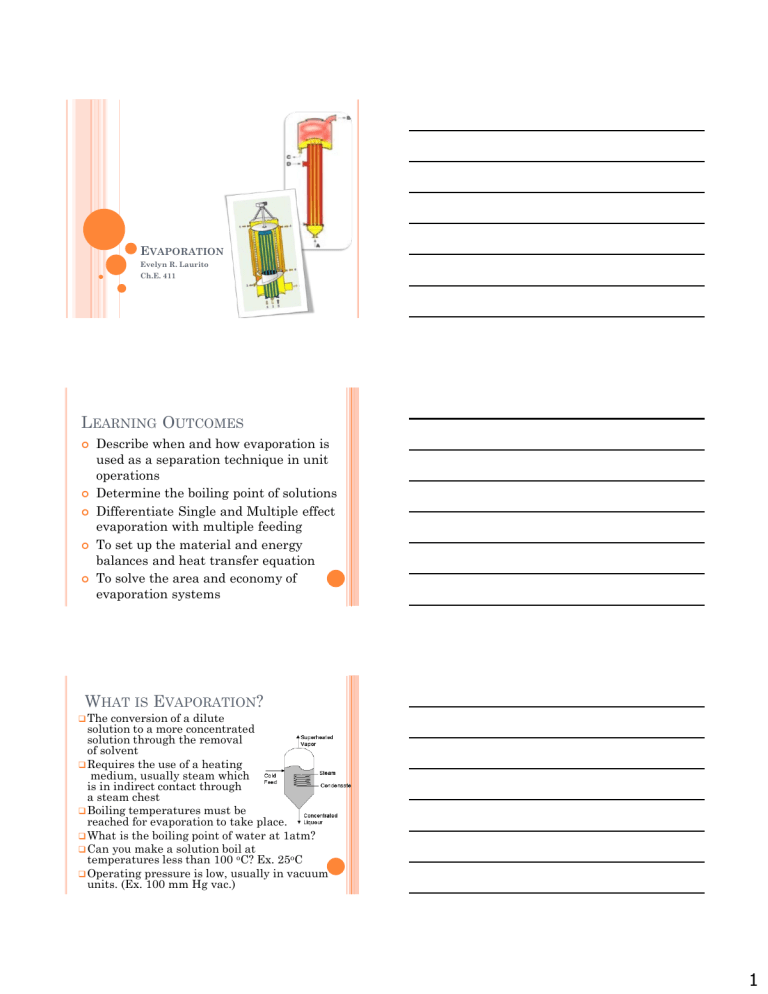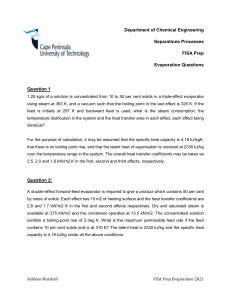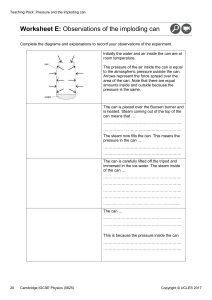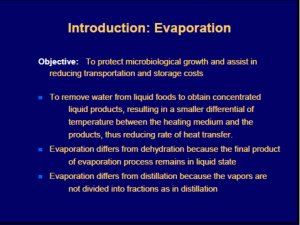
EVAPORATION Evelyn R. Laurito Ch.E. 411 LEARNING OUTCOMES Describe when and how evaporation is used as a separation technique in unit operations Determine the boiling point of solutions Differentiate Single and Multiple effect evaporation with multiple feeding To set up the material and energy balances and heat transfer equation To solve the area and economy of evaporation systems WHAT IS EVAPORATION? The conversion of a dilute solution to a more concentrated solution through the removal of solvent Requires the use of a heating medium, usually steam which is in indirect contact through a steam chest Boiling temperatures must be reached for evaporation to take place. What is the boiling point of water at 1atm? Can you make a solution boil at temperatures less than 100 oC? Ex. 25oC Operating pressure is low, usually in vacuum units. (Ex. 100 mm Hg vac.) 1 VAPOR STEAM THICK LIQUOR FEED CONDENSATE Rising Film Evaporator Vapor Rising Film Evaporator Feed Falling Film Evaporator Steam Thick Liquor Steam Condensate Vapor Condensate Feed Thick Liquor 2 Horizontal-Tube Evaporator Short-tube Evaporator WHAT IS BOILING POINT? Boiling point is the temperature at which the confining pressure becomes equal to the vapor pressure of the liquid. Boiling Point of Solution (T I) is greater than the Boiling Point of Solvent (T1) Boiling Point Elevation or Rise (BPR) = T I – T1 Strong electrolytes have significant BPR, but organic solutions usually have negligible BPR. Determination of BPR Colligative Property Equation: BPR = i Kb m Duhring’s Rule: The boiling point of solution varies linearly with the boiling point of pure solvent. (See Geankoplis, Fig. 8.4-2/538) Boiling Point Nomograph (See Fig. 11-124/11-112 or 11-115/8th ed)) 3 Find the BPR of a 2 molal solution of NaCl in water at 1 atm. Find the BPR of a 30% NaOH solution at 660 mm Hg vacuum (Tsatn=53.97oC). Find the BPR of 30% KCl at 1 atm solution using Colligative properties and Nomograph Duhring’s Chart for NaOH 4 H-x-T diagram for NaOH-H2O SINGLE EFFECT EVAPORATOR SINGLE EFFECT EVAPORATOR E, TI,HI P1 Vo, P0 Ts, Hs C, P0 Tc, hc F, xF TF, hF L, xL TI, hL F = feed or thin liquor rate L = thick liquor rate x = solute fraction E = evaporation rate or capacity P1 = operating pressure P0 = steam and condensate pressure Vo = steam rate = C = condensate rate Ts, Tc1 = steam, condensate temperatures TI = boiling point of L = T of vapor TF = feed temperature H, h = enthalpy symbols 5 MATERIAL BALANCES Overall Balance F + Vo = E + C + L (but Vo = C) F=E+L Solute Balance F xF = L xL = Throughput Rate Throughput Rate = constant ENTHALPY BALANCE General Form F hF + Vo Hs = E HI + C hc1 + L hL For systems w/ h-x-t Data (Ex. NaOH-H2O, Fp.504) Vo (Hs- hc1) = E HI + L hL – F hF = q hI, hF based on (xL,TI), (xF, TF) Hs, hc based on steam table For systems with negligible heat of dilution (no enthalpy data) with liquid enthalpy as zero at the boiling point of solution. hF = CPF (TF – TI); hL = CPL(TI- TI) = 0 HI = CPW(T1 – TI) + L1 + CPS (TI – T1) CPW = 4.187, CPS = 1.884, L1 = latent heat at T1 HI = L1 – 2.303 BPR NEGLIGIBLE HEAT OF DILUTION: USING TI AS REFERENCE TEMPERATURE: ASSUME THE FEED, THICK LIQUOR AND EVAPORATED SOLVENT ARE INITIALLY ALL LIQUID AT TI hF = CpF (TF - TI) hL = CpL (TI – TI) HE = 4.187 (T1-TI) + L1 + 1.884 (TI-T1) E starts as liquid water at TI, boils at T1 and becomes superheated vapor at TI or HE = L1 - 2.303(TI-T1) = L1 - 2.303 BPR In Engl Units: HE = L1 - 0.55 BPR Substituting into the Enthalpy balance eqn gives the following: Heat Balance Equation: q = Vo(Hs-hc) = E [L1 - 2.303BPR] + F CpF (TI-TF) 6 EVALUATION OF H S - HC Saturated Steam Condensing without subcooling: HS - hc = Lo = latent heat at To = sat’n temp. Superheated Steam Condensing without subcooling: HS - hc = 1.884(TS - To) + Lo Superheated Steam Condensing with subcooling: HS - hc = 1.884(TS - To)+ Lo + 4.187(To - Tc) Saturated Steam Condensing with subcooling: HS - hc = Lo + 4.187(To - Tc) HEAT TRANSFER EQUATION q = U A T q = heat rate supplied by steam = Vo (Hs – hc1) U = overall heat transfer coefficient A = heat transfer area needed T = effective temperature driving force = To – TI = To – T1 - BPR To = saturation temperature of steam EVAPORATOR ECONOMY (E) This is the ratio of evaporation rate or capacity to the steam rate e = E/Vo Ideally, e must be at least 1 to compensate for the steam condensation Single effect evaporation does not usually result in a high economy. 7 EXAMPLE 1 Ex.1] A single effect evaporator will handle 18,000 kg/hr of an organic colloid in water. The solution will be concentrated from 15% to 60% solids. Steam available is at 275 kPa and 140oC. The feed enters at 24oC with a specific heat of 3.768 kJ/kgK. A pressure of 660 mm Hg vacuum shall be maintained in the vapor space. The solution has a negligible BPR. Overall heat transfer coefficient is 2840 W/m2K. Calculate the economy and evaporator area. Given: Req'd: a) Economy b) A Sol'n: OMB: 18000 = L+E SB: 18000(.15) = L(.6) L = 4500 E = 13500 at Po = 275 kPa, To = 130.6oC, Lo = 2171.8 kJ/kg at 660 mm Hg vac or 100 mm Hg abs (13.33 kPa), T1 = 50.6oC L1 = 2379.1 kJ/kg HBE: q = Vo[Lo + 1.884 (Ts-To)] = EL1 + F CpF (T1 - TF) Vo[2171.8+1.884(140-130.6)] = 13500(2379.1)+18000(3.768)(50.6-24) solving: Vo = 15492 kg/hr a) Economy = E/Vo = 13500/15492 = 0.87 HTE: q = UA (T0-T1) = 2840 (3600/1000) A ( 130.6-50.6) solving : A = 41.47 m2 8 EX.2 Ex 2] A single effect evaporator is used to produce a concentrate of 10,000 kg/hr of a 20% solution of NaCl to 35% solids. Saturated steam is at 275 kPa and the vapor space at 100 mm Hg abs. Overall heat transfer coefficient is 1250 W/m2K. The feed enters at 30oC with Cp of 3.5 kJ/kgK. Calculate the economy and evaporator area. EX.2 Ex 2] A single effect evaporator is used to concentrate 20,000 lb/hr of a 20% solution of NaOH to 50% solids. Saturated steam is at 20 psig and the vapor space at 100 mm Hg. Overall heat transfer coefficient is 250 BTU/hr ft2-oF. The feed enters at 100oF. Calculate the economy and evaporator area. 9 Duhring’s Chart for NaOH H-x-T diagram for NaOH-H2O Given: Reqd: a)Economy b) A Soln: OMB: 20000 = L+E SB: 20000(.2) = L(.5) L = 8000 E = 12000 lb/hr EB: q = VoLo = EHE + LhL - FhF for steam at 20 psig or 34.7 psia, To = 258.7oF Lo = 939.5 BTU/lb for vapor: at 100 mm Hg or 1.93 psia, T1 = 124.7oF H1 = 1115.6 BTU/lb From Duhring's Chart: TI =(T1=124.7,xL=0.5) = 197oF BPR = 197 -124.7 = 72.3oF From Enthalpy- Concentration Diagram: hF = (TF=100oF, xF=0.2) = 55 BTU/lb hL = (TI=197oF, xL=0.5) = 221 BTU/lb Substituting in EBE: Vo(939.5) = 12000 [1115.6 + .45(72.3)] + 8000(221) -20000(55) Vo = 15375.8 lb/hr a) Economy = 12000/15375.8 = 0.78 HTE: q = VoLo = UA(To-TI) = 250 A (258.7-197) A = 936 ft2 10 EX.3 Ex 3] A single effect evaporator is used to concentrate 1000 kg/hr of a 10% solution of NaCl to 30% solids. Saturated steam is at 20 psig and the vapor space at 15 KPa. Overall heat transfer coefficient is 1250 W/m2K. The feed enters at 25 oC . Calculate the economy and evaporator area. Cp of NaCl solution as 2.1 kJ/kgK At 15 kPa: T1=53.97 oC L1= 2372.37 kJ/kg T1=129.15 oF At 20 psig or 239.2 kPa T0=125.9 oC L0=2185.3 kJ/kg Ex 3] A single effect evaporator is used to produce a concentrate of 1000 kg/hr of a 30% solution of KCl from a 10% solution. Saturated steam is at 20 psig and the vapor space at 15 KPa. Overall heat transfer coefficient is 1250 W/m2K. The feed enters at 25 oC . Calculate the economy and evaporator area. Cp of KCl solution as 2.1 kJ/kgK EXAMPLE 5 MT/hr of an aqueous solution with 10% sugar will be concentrated to 50% in a single evaporator system operating at 694 mm Hg vacuum. Saturated steam at 113oC will condense without subcooling in the steam chest. Assume that the feed has a specific heat of 3.5 kJ/kg-K, and the evaporator has an over-all coefficient of 2500 W/m2-K. Determine the steam requirement, economy and heat transfer area Needed for the evaporator if the feed enters at: at a) 25oC b) 43oC c) 70oC Answers: a)A = 15.7381m2 b)A = 15.2381m2 c)A = 14.4881m2 11 SOLUTION F 5000 xF 0.1 CpF 3.5 Ts 113 U 2500 Pv 694 P ( Pb Pv ) 760 1 xL 0.5 Pb 760 P 0.08571 1.01325 bar Material Balances: F = E + L F xF = L xL F xF L L 1000 xL E F L E 4000 SOLUTION Case of Negligible BPR/ No Enthalpy Data Enthalpy Balance: Vo (Hs - hc1) = E H I + L h I - F hF From steam table: T1 316 273 BPR 0 T1 43 HI L1 To Ts 273 L1 2579 179 hI 0 To 386 Lo 2222.6 TI T1 Lo 2696 473.4 HI 2400 SOLUTION TF 25 Vo e hF CpF TF TI E HI L hI F hF Lo E Vo Vo 4460.99163 e 0.89666 T Ts T1 A hF 63 Vo Lo U T 3.6 T 70 A 15.7381 12 SOLUTION hF CpF TF TI TF 43 Vo e E HI L hI F hF Lo E Vo 4319.26572 e 0.92608 Vo T Ts T1 A hF 0 T 70 Vo Lo A 15.2381 U T 3.6 SOLUTION TF 70 Vo e hF CpF TF TI E HI L hI F hF Lo E Vo hF 94.5 Vo 4106.67686 e 0.97402 T Ts T1 Vo Lo A U T 3.6 T 70 A 14.4881 13





